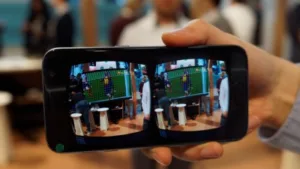Away from the main show at the older exhibition centre in Barcelona, Montjuic, the organisers held a special event called “Four Years from Now”, or 4YFN, that was designed for technology innovators from academia and start-ups. It was a lively event and we found a number of display-related companies, although the vast majority of companies were making apps of some kind, many of them variations on the themes of the biggest and successful platform developers.
 The sky was blue on the way to 4YFN at the Fira Montjuic Image:Meko
The sky was blue on the way to 4YFN at the Fira Montjuic Image:Meko
First we talked to KaiCast which was showing its projector blending and warping and tiling technology that was being demonstrated using three micro-projectors, with the company providing technology to distribute and render images, calibrate, warp and blend. The company told us that the key advantage that its technology has is that it doesn’t need a high powered GPU to do the calculation and can support arbitrary numbers of displays. The firm was using wireless to transmit the images to the ‘Intel stick PCs’ that were driving the displays and the company is working on its own end-point units which it is planning for Q3.
In the image on display, the system was masking an area to allow for a TV image to be integrated into the view. KaiCast can use data stored locally at each FullHD end point or it can be stored centrally offline. For central storage, the firm is developing a web-based CMS.
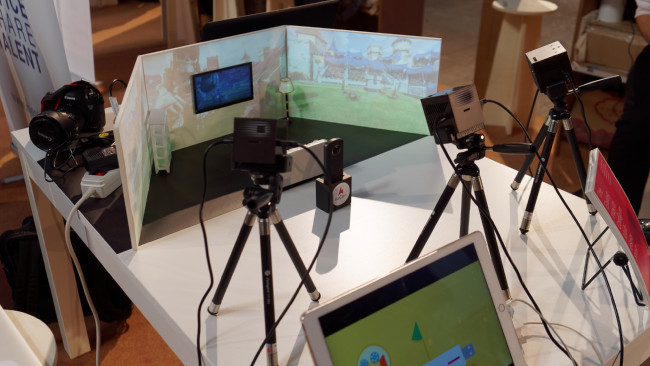 KaiCast can support screen tiling of arbitrary number of display. Image:Meko
KaiCast can support screen tiling of arbitrary number of display. Image:Meko
ThinkSilicon is developing very low power GPU and small-sized IP cores that can support operation using very low gate counts, compared to traditional devices. The complexity is low enough that the GPUs can be integrated (and were being demonstrated) using FGPAs. The company is optimistic that its technology could do well in IoT devices and wearables. However, the technology can also be scaled up to support resolutions up to 8K. The company also has image processing technology. The company has its own compression technology which can also be used for texture compression as well as low compression/high quality applications.
![]() ThinkSilicon graphics is designed for low power and FPGA-based devices. Image:Meko
ThinkSilicon graphics is designed for low power and FPGA-based devices. Image:Meko
Relumino from Korea is developing the use of VR headsets for the assistance of visually-impaired users. The company gave us a filter to simulate what the visually impaired would see. It then added smartphone-based VR glasses that were used to magnify (for text) and enhance (for text and graphics) the images presented. The result was that the images were somewhat clearer (it seemed that contrast and colour saturation was increased), while text was significantly enhanced, although the limited field of view made reading a little difficult. We would expect that with some practise, reading would get easier. The company currently has a $99 application but is also working on dedicated hardware.
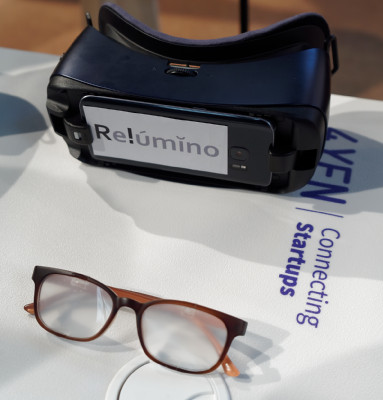 Relumino is developing visual aids for the partially-sighted. Image:Meko
Relumino is developing visual aids for the partially-sighted. Image:Meko
‘MonitorLess’ is a project being undertaken by Samsung to develop computing desktops that can be accessed using VR glasses. The system shown at the show used Wi-fi Direct to transmit data from the PC that controlled the monitor surface to transmit to the smartphone controlling the display device. Effectively, we were told, the PC with the display renders the screen to an ip address. The transparency of the virtual monitor can be controlled independently and the group told us that there is no real maximum number of virtual displays. The PC can be remote and LTE could be used to transmit the content to the smartphone that is used for the glasses. Eventually, dedicated A/R glasses might be used as displays. (and afterwards we saw reports that the group had shown some at MWC, but we didn’t see them!) There is a video of the concept here.
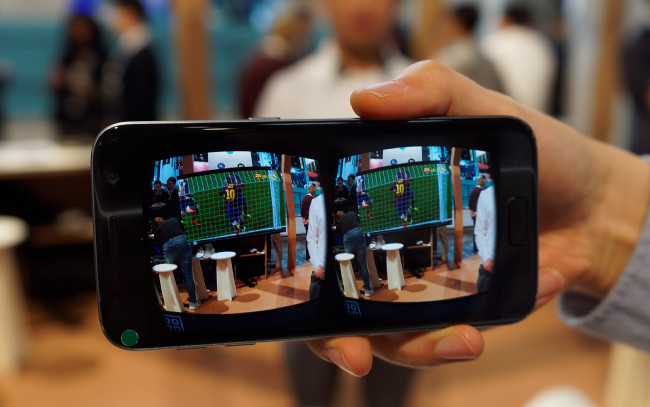 Samsung’s Monitorless project shows the video of soccer which is coming from a PC display. Image:Meko
Samsung’s Monitorless project shows the video of soccer which is coming from a PC display. Image:Meko
Oui Power has a two part magnetic power cable technology that can be used to support the iPhone Lightning port, Micro USB and now USB Type-C.
Everywoah is developing a platform for the transmission of realtime 360º content that can include important features for content owners such as watermarking. The company has also developed VR players and SDKs for apps to allow the integration of 360º content. The company plans to develop 3D later, but it has only been in business a matter of months and is busy with 2D video!
Sentio is the name now being used by the company behind the Andromium shell for Android smartphones which uses an 11.6″ display. The company was showing the latest shell design at MWC and told us that the main reason for the delay in its Kickstarter project has been the extra work being done to allow the multi window launcher software to fully support productivity applications, which makes the Android experience much more like a traditional worktop.
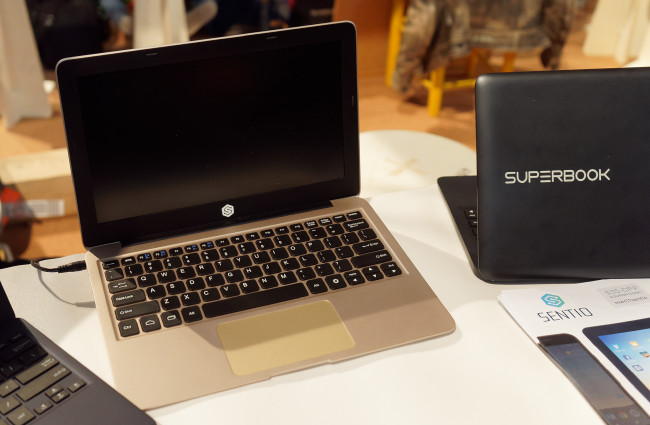 Sentio’s Android phone shell was previously known as Andromium
Sentio’s Android phone shell was previously known as Andromium
The Carbon is a very lightweight (107gms) and thin (4.6mm) that is built into a carbon fibre case. The phone has a 5.1″ AMOLED with FullHD and uses a decacore processor with 4GB of RAM and 128GB of storage. The display is protected by Gorilla Glass 4 and the main camera is a 16MP unit based on the Sony IMX298 with autofocus. There is a 5MP selfie camera. The phone runs Android 6.0. The phone will start shipping in March and will cost £759 ($769 + tax) from www.carbonmobile.com. Early buyers will receive a carbon fibre/Kevlar cover free.
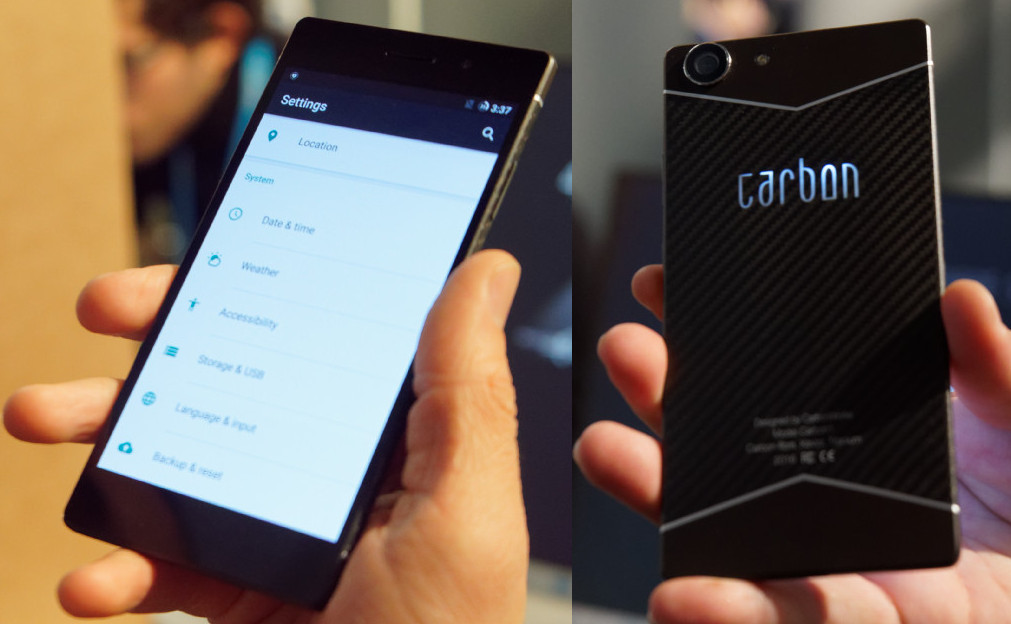 Carbon’s phone is just 4.9mm thick. Image:Meko
Carbon’s phone is just 4.9mm thick. Image:Meko
Broomx.com is developing an unusual device that uses a 4K laser projector (maker unidentified and perhaps undecided!) and a fisheye lens to project content from VR or 360º videos onto the walls of a room to create ‘immersive rooms’. There is also an add-on module that projects in a standard way to create a higher resolution centre to the image. The firm is still in development and didn’t have any hardware at the show, although it was getting quite a lot of attention. It hopes to have a product in ‘3-6 months’ and wants to sell both to consumers and to event organisers. We thought that there might be some interest in the concept, but the firm has a rental-based business model that will cost €800 per month. That would limit consumer sales to a small segment! (It showed the concept of videos covering the walls of a bedroom. I’m not sure I’d want to see what might be projected there!).
 Broomx is planning to use two projectors, one for the whole room, the other for a high resolution window. Image:Meko
Broomx is planning to use two projectors, one for the whole room, the other for a high resolution window. Image:Meko
We enjoyed the 4YFN show and will ensure we get there again! (BR)

